The Toyota Tund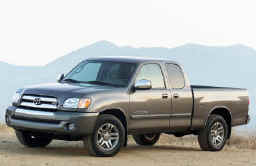 ra
gets a significant increase in power for 2005, and fuel economy
has been improved. A new 4.0-liter V6 delivers 245 horsepower,
matching the output of last year's V8 and representing an
increase in power of nearly 30 percent over last year's V6.
Meanwhile, the 4.7-liter double overhead-cam V8 has been refined
with Toyota's VVT-i technology, bringing it up to 282
horsepower, an increase of 42 horsepower over last year's V8.
Both engines are now available
with responsive five-speed automatics; and the V6 is available
with a new six-speed manual transmission. There are other
refinements as well.
ra
gets a significant increase in power for 2005, and fuel economy
has been improved. A new 4.0-liter V6 delivers 245 horsepower,
matching the output of last year's V8 and representing an
increase in power of nearly 30 percent over last year's V6.
Meanwhile, the 4.7-liter double overhead-cam V8 has been refined
with Toyota's VVT-i technology, bringing it up to 282
horsepower, an increase of 42 horsepower over last year's V8.
Both engines are now available
with responsive five-speed automatics; and the V6 is available
with a new six-speed manual transmission. There are other
refinements as well.
The Tundra is one of the
smoothest, quietest, and most refined pickups we've driven. It's
more agile than other full-size pickups, at least partly because
it's slightly smaller. The Tundra feels quick and responsive,
lighter on its feet and more refined than the domestic trucks.
Buyer's appreciate that it's built to Toyota's high standards of
quality, durability and reliability.
However, the Tundra isn't
quite as full-sized as the new Nissan Titan nor is it as big as
the domestic pickups, namely the Ford F-150, Dodge Ram,
Chevrolet Silverado, and GMC Sierra. Critics call it a 7/8ths
truck. It isn't quite as good at being a truck as the other
trucks when hauling or towing, but it's capable of hauling up to
2025 pounds or towing up to 7100, if equipped to do so. Not
everyone needs the ultimate in truck capability, though. For
them, the Tundra offers plenty of capability to perform the work
they ask of it, and its refinement and handling makes it a good
alternative to a car.
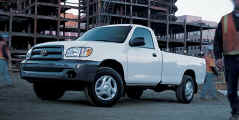 Like
the domestic trucks, Tundra is available with regular cab,
extended cab, and crew cab (Double Cab) bodies. The Double Cab
is more than three inches taller, and is built on a longer
chassis than the other Tundra models; so it comes a little
closer to being a true full-size pickup. It features a deep,
six-foot bed and an adult-friendly back seat.
Like
the domestic trucks, Tundra is available with regular cab,
extended cab, and crew cab (Double Cab) bodies. The Double Cab
is more than three inches taller, and is built on a longer
chassis than the other Tundra models; so it comes a little
closer to being a true full-size pickup. It features a deep,
six-foot bed and an adult-friendly back seat.
In addition to more
horsepower, some Tundra models have acquired more standard
equipment for 2005, including a tire-pressure monitoring system.
Model
Lineup
Toyota
Tundra is available as a two-door Regular Cab, an extended
Access Cab with auxiliary rear doors, and as a true four-door
Double Cab. Two- and four-wheel-drive
versions are offered, employing similar suspensions and bed
heights. Three trim levels are available: base, SR5, and
Limited. Access Cab V8 models are available with a full-width or
stepside bed.
 Two
engines are available, and both are more potent for 2005. The
base V6 has grown from 3.4 to 4.0 liters. It still breathes
through dual-overhead-cam (DOHC) heads, and now uses Toyota's
computer-controlled variable valve timing with intelligence (VVT-i)
to produce 245 horsepower, 5 more than last year's V8, and 55
more than the 190-horsepower rating of the 2004 V6. Torque is up
significantly as well, from 220 to 282 pound-feet. The optional
i-Force DOHC V8 sticks with its previous 4.7-liter displacement,
but acquires VVT-i to boost horsepower from 240 to 282, and
torque from 315 pound-feet to 325. Transmissions are new, too.
The V6 now comes with a new six-speed manual. A new five-speed
automatic is optional ($770-$840) with the V6, standard with the
V8.
Two
engines are available, and both are more potent for 2005. The
base V6 has grown from 3.4 to 4.0 liters. It still breathes
through dual-overhead-cam (DOHC) heads, and now uses Toyota's
computer-controlled variable valve timing with intelligence (VVT-i)
to produce 245 horsepower, 5 more than last year's V8, and 55
more than the 190-horsepower rating of the 2004 V6. Torque is up
significantly as well, from 220 to 282 pound-feet. The optional
i-Force DOHC V8 sticks with its previous 4.7-liter displacement,
but acquires VVT-i to boost horsepower from 240 to 282, and
torque from 315 pound-feet to 325. Transmissions are new, too.
The V6 now comes with a new six-speed manual. A new five-speed
automatic is optional ($770-$840) with the V6, standard with the
V8.
Base models are pretty plain,
starting with the V6 Regular Cab 2WD with six-speed manual
($15,955). Bumpers are painted, but anti-lock brakes (ABS) are
standard. Air conditioning is optional, either as a stand-alone
($985) or as part of a package ($1620) that includes wheel
covers, mud guards, intermittent wipers, tilt steering, and a
sliding rear window.
SR5 models offer the option
of an Access Cab ($22,410) or Double Cab ($26,120); and two or
four-wheel drive. SR5 models come standard with air
conditioning; cruise control; tilt steering; power windows,
locks and mirrors; remote keyless entry; sliding rear window;
AM/FM/cassette stereo; tachometer; color-keyed front and chromed
rear bumper; styled steel wheels; and other trim upgrades. The
V6 and six-speed manual are standard in SR5 Access Cabs, but the
five-speed automatic is available, as is the V8 engine. The V8
is standard in SR5 Double Cabs.
Limited models come standard
with the V8, and are available in Access Cab ($27,075) or Double
Cab ($29,745). The Limited's long list of standard equipment
includes an in-dash CD changer, steering-wheel-mounted audio
controls, and an anti-theft system. Limited models also get a
power rear window.
Four-wheel drive 4WD adds
about $3300 to the SR5 and Limited prices above. A Sport
Suspension Package for 2WD V8 models features Tokico shocks,
springs tuned for handling, a 3.91:1 limited-slip rear
differential, and Graphite-tone 17-inch alloy wheels wearing
P265/65R17 tires.
Walkaround
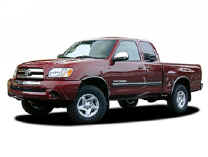 The
Toyota Tundra is a good-looking truck, with a bold grille
opening that extends down into the bumper. The heavy-looking
chrome grille bars faintly suggest the 1947 GMC design, a model
now popular with collectors. Curving lines give the Tundra a
sporty appearance, while bulging fenders make it look ready to
go off road. However, the Tundra's styling is bland compared to
the Nissan Titan, Dodge Ram, or Ford F-150. Toyota's StepSide
body is more svelte than macho. I don't like it.
The
Toyota Tundra is a good-looking truck, with a bold grille
opening that extends down into the bumper. The heavy-looking
chrome grille bars faintly suggest the 1947 GMC design, a model
now popular with collectors. Curving lines give the Tundra a
sporty appearance, while bulging fenders make it look ready to
go off road. However, the Tundra's styling is bland compared to
the Nissan Titan, Dodge Ram, or Ford F-150. Toyota's StepSide
body is more svelte than macho. I don't like it.
The Tundra Double Cab looks
bigger and brawnier than the Regular Cab and Access Cab models.
That's because it is bigger, not only longer in wheelbase, but
more than three inches taller as well. Around back, Double Cab
models sport unique taillights. At 74.3 inches, the Double Cab's
bed is just a half-inch shorter than the Access Cab's. The
Double Cab's four doors are traditional front-hinged doors.
 Access
Cab models have four doors, but the short rear doors are hinged
at the rear and open opposite the front doors. As with other
extended cabs, the doors on the Access Cab will bang into one
another if you close the front door before closing the rear
door. Fortunately, the inside of the rear door is padded, so
this isn't a big problem. Handles for the rear doors are
conveniently located on the outside, whereas most domestic
pickups with extended cabs hide the handles inside the door
jams. Unfortunately, the handle design isn't the most
comfortable to use.
Access
Cab models have four doors, but the short rear doors are hinged
at the rear and open opposite the front doors. As with other
extended cabs, the doors on the Access Cab will bang into one
another if you close the front door before closing the rear
door. Fortunately, the inside of the rear door is padded, so
this isn't a big problem. Handles for the rear doors are
conveniently located on the outside, whereas most domestic
pickups with extended cabs hide the handles inside the door
jams. Unfortunately, the handle design isn't the most
comfortable to use.
Regular Cab beds stretch over
8 feet, but the Access Cab's bed measures only 6 feet 3 inches.
That's a few inches inches shorter than the medium-length bed
offered on a Ford F-150 Supercab, but 7.7 inches longer than an
F-150 Supercab's shortest bed (which still requires a wheelbase
4.4 inches longer than the Toyota's). Toyota's bed is 5 inches
shallower than Ford's, 2.3 inches shallower than the Chevrolet
Silverado's.
Double Cab beds are only
about a half-inch shorter than the Access Cab's. The Double
Cab's bed is 20.7 inches deep, 3.5 inches deeper than the beds
of the Regular Cab and Access Cab. That makes it slightly deeper
than the Nissan Titan Crew Cab's bed, though still not as deep
as the Ford's.
Interior
Features
The Tundra is a
comfortable truck with a friendly interior. Front-seat roominess
is competitive with other
full-size pickups. Toyota claims the Tundra provides more front
legroom than any of the domestic pickups, though only by about
half an inch; and the Nissan Titan has only a tiny edge over
Tundra. The others, especially the F-150, offer more hip room
than the Tundra, however, and owners notice that.
The Double Cab is slightly
roomier than the other Tundra models. It offers an inch more
front headroom and a fraction more front-seat hip and leg room.
 The
60/40 split-bench cloth seats that are standard in most models
are welcoming and supportive. Double Cabs come with bucket seats
up front, rather than the split bench.
The
60/40 split-bench cloth seats that are standard in most models
are welcoming and supportive. Double Cabs come with bucket seats
up front, rather than the split bench.
Climbing in is easy, though
the two-wheel-drive model seems to sit higher off the ground
than other two-wheel-drive pickups. The Tundra feels tall in the
saddle, giving the driver a commanding view over shorter
vehicles.
Accessory switches are
concentrated in the center cluster for easy operation. The fake
wood on the dash is dreadful, but the instruments are
straightforward, with a big tachometer on all but base models. A
center console with four nice, big cup holders; dual map
pockets; and covered storage is shared with the Toyota Sequoia
SUV. Its lid holds a pad for note-taking, but it felt flimsy
when we tried to use it. Double sun visors with extenders are
useful at sunrise and sunset.
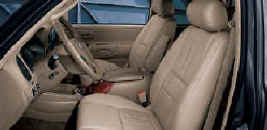 Access Cabs add interior
storage space and the ability to carry two more passengers. If
those passengers are adults, however, the rear seat is a
short-term affair. The Tundra does not have nearly as much space
in the rear compartment of its extended cab as the other
full-size pickups. And the rear seatback is vertical, forcing
occupants to sit bolt upright, uncomfortable for traveling any
farther than the neighborhood restaurant. A far better use for
the extended cab is carrying dry cleaning, groceries,
briefcases, outdoor gear, or anything else that should be
shielded from the elements. Unfortunately, the rear seat takes
up a fair amount of room. The seat bottom on the split bench can
be flipped up, but the seat doesn't fold completely out of the
way, nor can it be easily removed. Some of the domestic extended
cabs offer much better versatility.
Access Cabs add interior
storage space and the ability to carry two more passengers. If
those passengers are adults, however, the rear seat is a
short-term affair. The Tundra does not have nearly as much space
in the rear compartment of its extended cab as the other
full-size pickups. And the rear seatback is vertical, forcing
occupants to sit bolt upright, uncomfortable for traveling any
farther than the neighborhood restaurant. A far better use for
the extended cab is carrying dry cleaning, groceries,
briefcases, outdoor gear, or anything else that should be
shielded from the elements. Unfortunately, the rear seat takes
up a fair amount of room. The seat bottom on the split bench can
be flipped up, but the seat doesn't fold completely out of the
way, nor can it be easily removed. Some of the domestic extended
cabs offer much better versatility.
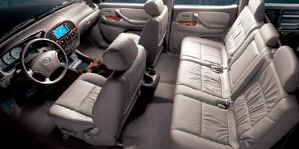 Double
Cabs, on the other hand, provide genuinely useful space for
adult passengers in the back seats. Its 37.5 inches of rear-seat
legroom make for comfortable accommodations, though Tundra's
back seat still doesn't have as much space as in the Nissan
Titan, Ford F-150, Chevrolet Silverado or GMC Sierra. But
Tundra's rear seatback reclines at an angle of 24 degrees,
adding to comfort. Each rear seating position has a headrest and
three-point safety belt. Rear-seat passengers also enjoy their
own heating and air conditioning outlets, and optional audio and
DVD entertainment systems. Tundra Double Cab also offers the
segment's first vertical power-sliding rear window. At 750
square
Double
Cabs, on the other hand, provide genuinely useful space for
adult passengers in the back seats. Its 37.5 inches of rear-seat
legroom make for comfortable accommodations, though Tundra's
back seat still doesn't have as much space as in the Nissan
Titan, Ford F-150, Chevrolet Silverado or GMC Sierra. But
Tundra's rear seatback reclines at an angle of 24 degrees,
adding to comfort. Each rear seating position has a headrest and
three-point safety belt. Rear-seat passengers also enjoy their
own heating and air conditioning outlets, and optional audio and
DVD entertainment systems. Tundra Double Cab also offers the
segment's first vertical power-sliding rear window. At 750
square
inches, the Double Cab's rear
window offers more than four times the open area of the manual
sliding rear windows in the Regular Cab and Access Cab models,
making it easier to access the bed especially important with a
canopy. When the Double Cab's 60/40 split rear seat isn't
occupied, it folds and tumbles to provide lockable,
weather-tight storage space inside the cab.
Safety features for all
Tundra models include seatbelt pre-tensioners and force
limiters, along with the required dual front airbags. The
passenger-side airbag can be switched off with the key when
babies or children occupy the front passenger seat. A
tire-pressure monitor is now standard.
Driving
Impressions
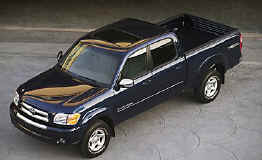 The
Toyota Tundra rides almost as quietly as a luxury sedan, whether
it's a four-wheel-drive or two-wheel-drive model. This is the
quietest pickup we've driven. There's little wind noise or road
noise in the cabin. Ride quality is quite smooth for a truck. It
feels truly refined.
The
Toyota Tundra rides almost as quietly as a luxury sedan, whether
it's a four-wheel-drive or two-wheel-drive model. This is the
quietest pickup we've driven. There's little wind noise or road
noise in the cabin. Ride quality is quite smooth for a truck. It
feels truly refined.
Toyota's V8 is silky smooth,
quick, and extremely responsive. The Tundra was previously
sensitive at throttle tip-in, but it seems like that's been
addressed with the 2005 models, so it doesn't lurch off the
line. It also puts power to the rear wheels without wheelspin,
providing excellent acceleration and stability. It's very
responsive in the 45-mph range, so passing on two-lane roads is
easy. And it sounds great. Stand behind the Tundra when it is
started, revved, or even idling, and you're treated to a classic
V8 burble that's pleasant to American ears. Yet, it's
super-quiet when sitting inside the truck or standing in front
of it.
V8 engines with twin cams and
four valves per cylinder are usually associated with imported
luxury sports sedans. Toyota perfected this design in its Land
Cruiser and its Lexus luxury vehicles. For 2005, Toyota has
added electronically controlled variable valve timing with
intelligence (VVT-i) to the V8's long list of state-of-the-art
features. So from the same 4.7 liters, it now produces 282
horsepower at 5400 rpm; and 325 pound-feet of torque at 3400
rpm. That's 42 more horsepower and 10 more pound-feet than last
year's model, which already delivered quick response around town
and strong power for towing and hauling.
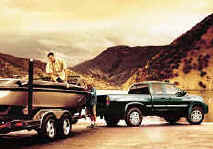 Starting from a dead stop, a
two-wheel-drive Tundra Limited easily accelerated up a long
steep grade while pulling a 3,000-pound trailer. This tow rig
was stable going around sweeping turns, and when braking from
high speeds on steep downhill sections. There were none of the
up and down motions when bouncing at low speed over a rough,
lava-covered dirt road that some trucks exhibit when their front
suspensions aren't up to balancing the weight on the rear
tongue. Transmission and engine oil coolers are standard on
Double Cab models.
Starting from a dead stop, a
two-wheel-drive Tundra Limited easily accelerated up a long
steep grade while pulling a 3,000-pound trailer. This tow rig
was stable going around sweeping turns, and when braking from
high speeds on steep downhill sections. There were none of the
up and down motions when bouncing at low speed over a rough,
lava-covered dirt road that some trucks exhibit when their front
suspensions aren't up to balancing the weight on the rear
tongue. Transmission and engine oil coolers are standard on
Double Cab models.
The new base-level V6 is
larger than last year's, at 4.0 liters compared to 3.4. Also
equipped with dual overhead cams, four valves per cylinder, and
VVT-i, it produces 245 horsepower at 5200 rpm, and its 282
pound-feet of torque at 3800 rpm represents a 28 percent
increase over the 2004 V6.
Ride quality is excellent,
maybe the best of the full-size pickups on bumpy freeways in Los
Angeles. On rough pavement and bumpy dirt roads, the Tundra's
suspension really shines. It damps out unwanted vibration and
harshness and controls the movement of the wheels precisely,
keeping the tires in contact with the road surface for excellent
grip and handling. The 4WD suspension performed amazingly well
and was easy to control when bouncing up a steep mountain trail
on the Big Island of Hawaii. Bounding over harsh dips and humps,
the suspension offered impressive travel and damping. It never
hit the bump stops in spite of our efforts to beat it up. While
bouncing over moguls, we noticed that neither the cowl nor the
front hood shook. The Tundra's chassis is highly rigid with
boxed front frame rails. Toyota also claims this truck offers
class-leading ground clearance, and that everything underneath
is tucked above the frame rails.
In Alaska, we found the 2005
Tundra's steering too slow and too light, and it seemed to
require correction to maintain a straight course down the
highway. Yet the Tundra was impressively composed in awkward
situations. When making a quick Y-turn, then taking off, it
doesn't generate the head toss often associated with
awkward-handling trucks. It's a difficult phenomenon to
describe, but makes the Tundra a very pleasant companion.
For off-road travel, Toyota
offers the TRD Off-Road Package, developed with Toyota racing
legend Ivan "Ironman" Stewart. Using Bilstein shocks
and special progressive-rate springs, this suspension is
designed for performance off road and we found it improved the
handling on rough unpaved roads. We were surprised to discover
it also offers a smoother ride on rough road surfaces than the
standard suspension.
A Sport Suspension Package is
available that's designed to offer better handling on paved
roads.
The brakes felt great even
when pulling a trailer, smooth and easy to modulate in normal
driving and powerful when needed.
Final
Word
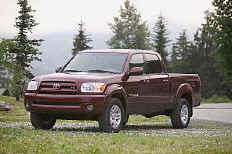 The
Toyota Tundra may not boast the brawny looks and heavy-duty
capability of other full-size pickups, but it is smooth and
quiet, light on its feet, and easy and enjoyable to drive on a
daily basis.
The
Toyota Tundra may not boast the brawny looks and heavy-duty
capability of other full-size pickups, but it is smooth and
quiet, light on its feet, and easy and enjoyable to drive on a
daily basis.
The 2005 Tundra has been
improved and further refined. There's more power for passing or
towing, whether you choose the V6 or V8. All of this, wrapped up
with Toyota's renowned quality, durability and reliability, make
the Tundra a good choice among full-size pickup trucks.
New Car Test Drive editor
Mitch McCullough filed this report from Alaska.
Provided
by:

Source: New
Car Test Drive
![]()
![]()
![]()